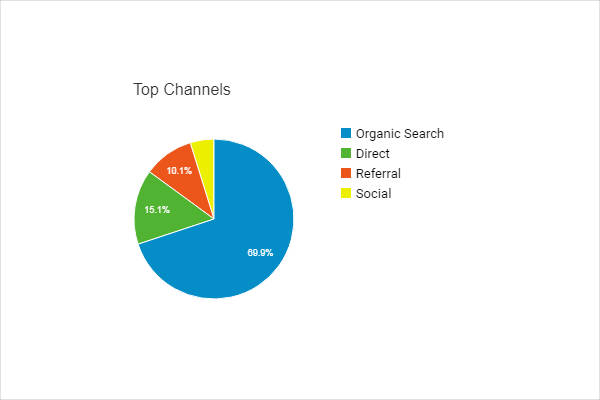Do you know that there is a key mistake being committed by business owners all around the world right now as you read this? That mistake is considering digital marketing to be a superfluous expense. Despite how wrong that can be, it is somewhat understandable when you take into account how unpredictable the return on investment can be. What separates the reality of digital marketing from its many myths, turning it into an actual science in the process, is the act of measuring.
Business owners who do more accurate measuring are the ones who can mitigate the level of unpredictability involved, but what makes all the difference in the world is being knowledgeable enough to pull this off. It is imperative for business owners to familiarize themselves with the different marketing metrics. Below are a few that you can read about for the benefit of your business.
- The Total Number of Visits: When it comes to catering to your present customers and attracting potential ones, your main website should be the main focus. Knowing how many are visiting is a key component to various strategies that you may be in the process of developing. By measuring your website’s total number of visits, you provide yourself with a ‘big picture’ vision regarding how well the present campaign is doing. Should you notice a drop in numbers on a particular month, it shouldn’t take long for you to find out why this is so. A steady increase in visitors is considered healthy for any business.

- Traffic that is Channel-Specific: Being aware of channel-specific metrics is quite helpful when it comes to pinpointing which channels are performing well and which ones are not. Business owners may divide their attention on fair main channels, which are:
- Direct Visitors: These are the people who visit your site by directly typing the URL into the browser.
- Organic: These are the people who come across your site through the use of a search query.
- Referrals: These are the people who end up visiting your site because of a link from another site.
- Social Media: These are the people who visit your social media platforms. This can be a significant channel to observe since it can give you an idea of just how effective your content marketing is, along with any other digital campaign you may be overseeing.

- Brand New Sessions: This is a metric that you can find in Google Analytics which shows you how many new site visitors you have as opposed to recurring ones. Making use of this is an excellent way to know just how encouraging your site is to be new people and how effective it is in keeping customers around.
- The Total Number of Conversions: As far as metrics are concerned, your number of conversions rank as among the most important to consider. You may define conversations in various ways and even measure them from your site directly, although this is dependent on how your site is built. An alternative would be setting up a Google Analytics goal to help you track your progress. Having low numbers could mean a lot of things; bad design, disinterested visitor, and poor offerings are just a few examples.

- Lead to Close Ratio: This is more of a measurement regarding the success of your sales as opposed to a measurement of your digital marketing efforts. As far as your ROI is concerned, this is still a significant topic to discuss. When businesses neglect successful and efficient sales follow-ups, know that this makes your leads largely useless. For this metric, all you have to do is divide your number of sales by the number of leads you have. From there, you will get a ratio that easily defines your success in sales that is independent of any marketing efforts you may have. Should your close rate be quite low, you can expect things like drops in revenue to be a symptom of inefficient sales strategies.
- Cost Per Lead: This metric will depend on what strategy you used for your lead generation channels, making this one of the more specific metrics to look into. For you to be able to do this, you need to first look at your campaign’s average monthly cost then compare it with a specific channel’s total number of leads generated. Here’s a tip: never neglect to incorporate any ‘invisible costs’ on your part, which would include startup costs, management time, and any other peripheral expenses.

- Customer Value: You can expect customer value to be ones particularly difficult to calculate. Although it does not inform you about how well your efforts are doing, it can be helpful when it comes to determining what your return on investment will be overall. You can even use this metric to help you set up annual goals for your company. Getting your customer value means taking into account the sales your average customer initiates, making this nearly impossible for startups.

- Your Projected Return on Investment: As far as digital marketing campaign factors are concerned, this would be the most significant due to its demonstration of profitability. Having a positive return on investment becomes a testament to your campaign’s effectiveness; negative ROI will, on the other hand, indicate a need for more adjustment. Calculating your ROI will require comparing the cost per lead against the lead to close ration, as well as comparing that specific figure against the business’ average customer value.

Now that you have properly familiarized yourself with the metrics, the next logical step from here would be to do regular check-ups. In doing so, you can get accurate ideas regarding how well your marketing campaigns are doing. You can expect to be able to find more ways to refine your tactics as you go, as well as seeing for yourself which of your strategies are working out. The more you learn, the greater chances you will have of creating a steady digital marketing rhythm that is capable of generating enough leads to cover the costs of your all your efforts.
Related Posts
Awesome Email Marketing Trends for 2016
Must-Use Marketing Tools for 2017 Design Trends
44+ Ad Design Templates
44+ Packaging Designs
20+ Business Flyer Templates
20+ Half Fold Brochures
20+ Cupcake Vectors
20+ Real Estate Flyer Templates
11+ Advertising Flyer Designs
Education Banner Designs
PSD Flyer Designs
Real Estate Banner Designs
33+ Creative Bee Logo Designs
24+ Real Estate Flyer Designs
21+ Fashion Flyer Designs
